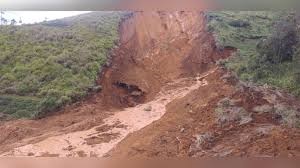A wave of deadly landslides triggered by torrential rains has struck China’s southwestern Guizhou province, killing at least four people and leaving 17 others missing, according to Chinese authorities. The disaster has prompted a large-scale rescue operation involving military personnel and national emergency teams as the region reels under the mounting effects of climate change.

The landslides occurred in multiple locations across the province, including Changshi township and Qingyang village. In Changshi alone two people were killed, and several others remain trapped. In Guowa township, 19 residents from eight households were reported missing after homes were buried in debris and mud.
As rainfall continues China’s Ministry of Natural Resources has increased the emergency response level, warning of more geological hazards in the coming days. The National Disaster Prevention Commission has also deployed rapid-response teams to guide local relief efforts and evacuate vulnerable communities.
Military Joins Rescue Efforts Amid Rising Risks
With 17 people still unaccounted for, the Chinese military has been brought in to assist search and rescue teams navigating difficult terrain made worse by saturated soil and continuous rainfall. Drones, sniffer dogs, and heavy machinery are being used to clear rubble and locate survivors.
According to officials weather conditions remain hazardous with more rain forecast for the region through the week.
Climate Crisis Amplifies Extreme Weather Threat
Experts warn that this disaster is part of a broader trend of climate-related extremes affecting China. Guizhou a mountainous and landslide-prone province has faced increasingly erratic and intense weather. In 2024, China recorded its hottest year ever, with prolonged heatwaves followed by severe monsoon rains a pattern that scientists link directly to global climate change.
“This tragedy underscores China’s vulnerability to overlapping climate threats,Regions like Guizhou are now facing intensified seasonal rains, worsened by deforestation, urban sprawl, and rising global temperatures said a disaster risk analyst based in Beijing.
Ongoing Crisis, Uncertain Recovery
As rescue operations continue, the government has called for heightened disaster preparedness across southwestern China. Authorities have also urged local residents in high-risk areas to evacuate if needed and to follow updated weather alerts.
The full extent of damage remains unclear, but the incident marks another reminder of the urgent need for robust climate adaptation strategies across China’s rural and disaster-prone provinces.
